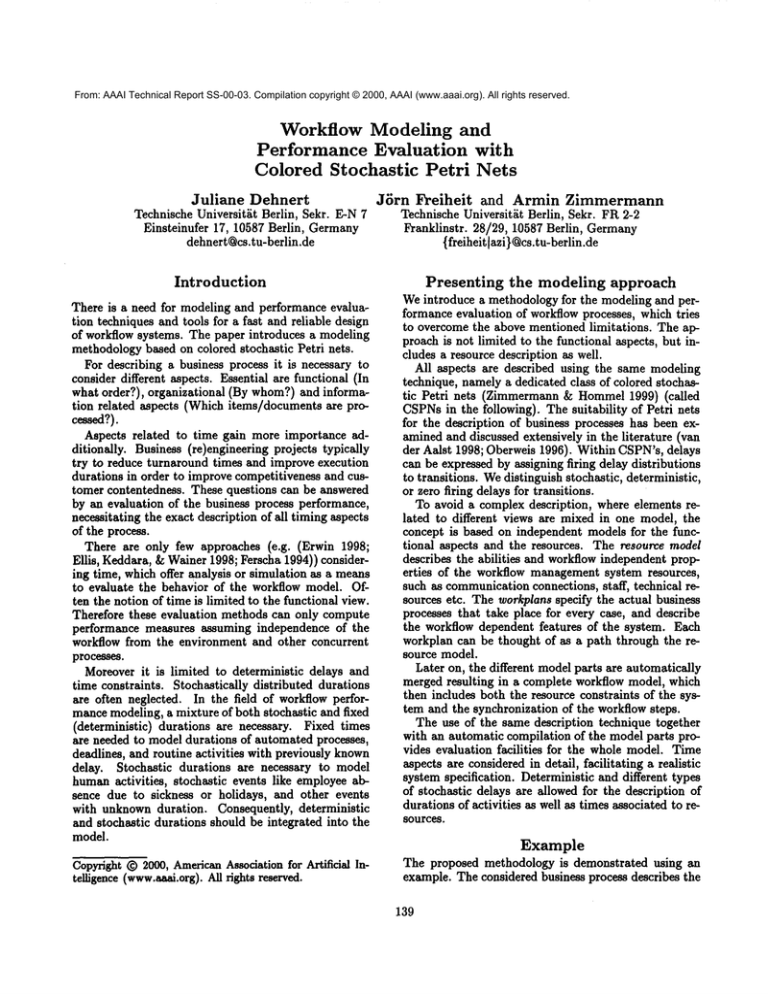
From: AAAI Technical Report SS-00-03. Compilation copyright © 2000, AAAI (www.aaai.org). All rights reserved.
Workflow Modeling and
Performance Evaluation with
Colored Stochastic Petri Nets
Juliane
Dehnert
JSrn
Freiheit
and Armin Zimmermann
Technische Universit~t Berlin, Sekr. F,-N 7
Technische Universit~it Berlin, Sekr. FR 2-2
Einsteinufer 17, 10587 Berlin, Germany
Franklinstr. 28/29, 1.0587 Berlin, Germany
dehnert@cs.tu-berlin.de
{freiheit lazi}@cs.tu-berlin.de
Introduction
There is a need for modeling and performance evaluation techniques and tools for a fast and reliable design
of workflow systems. The paper introduces a modeling
methodologybased on colored stochastic Petri nets.
For describing a business process it is necessary to
consider different aspects. Essential are functional (In
what order?), organizational (By whom?)and information related aspects (Which items/documents are processed?).
Aspects related to time gain more importance additionally. Business (re)engineering projects typically
try to reduce turnaround times and improve execution
durations in order to improve competitiveness and customer contentedness. These questions can be answered
by an evaluation of the business process performance,
necessitating the exact description of all timing aspects
of the process.
There are only few approaches (e.g. (Erwin 1998;
Ellis, Keddara, & Wainer 1998; Ferscha 1994)) considering time, which offer analysis or simulation as a means
to evaluate the behavior of the workflow model. Often the notion of time is limited to the functional view.
Therefore these evaluation methods can only compute
performance measures assuming independence of the
workftow from the environment and other concurrent
processes.
Moreover it is limited to deterministic delays and
time constraints. Stochastically distributed durations
are often neglected. In the field of worldtow performance modeling, a mixture of both stochastic and fixed
(deterministic) durations are necessary. Fixed times
are needed to model durations of automated processes,
deadlines, and routine activities with previously known
delay. Stochastic durations are necessary to model
humanactivities,
stochastic events like employee absence due to sickness or holidays, and other events
with unknown duration. Consequently, deterministic
and stochastic durations should be integrated into the
model.
Copyright
(~)2000,
American
Association
forArtificial
Intelligence
(www.aaai.org).
Allrights
reserved.
Presenting
the modeling
approach
Weintroduce a methodology for the modeling and performance evaluation of workflow processes, which tries
to overcome the above mentioned limitations. The approach is not limited to the functional aspects, but includes a resource description as well.
All aspects are described using the same modeling
technique, namely a dedicated class of colored stochastic Petri nets (Zimmermann& Hommel1999) (called
CSPNsin the following). The suitability of Petri nets
for the description of business processes has been examined and discussed extensively in the literature (van
der Aalst 1998; Oberweis 1996). Within CSPN’s, delays
can be expressed by assigning firing delay distributions
to transitions. Wedistinguish stochastic, deterministic,
or zero firing delays for transitions.
To avoid a complex description, where elements related to different views are mixed in one model, the
concept is based on independent models for the functional aspects and the resources. The resource model
describes the abilities and workflow independent properties of the worldlow management system resources,
such as communicationconnections, staff, technical resources etc. The workplans specify the actual business
processes that take place for every case, and describe
the workflow dependent features of the system. Each
workplan can be thought of as a path through the resource model.
Later on, the different model parts are automatically
merged resulting in a complete workflow model, which
then includes both the resource constraints of the system and the synchronization of the workflow steps.
The use of the same description technique together
with an automatic compilation of the model parts provides evaluation facilities
for the whole model. Time
aspects are considered in detail, facilitating a realistic
system specification. Deterministic and different types
of stochastic delays are allowed for the description of
durations of activities as well as times associated to resources.
Example
The proposed methodology is demonstrated using an
example. The considered business process describes the
139
handling
of damages
andlossesin a transport
company.
A claimhandling
startswhena customer
messagearrives,informing
abouta newdamageevent,it passes
inspection
andsomekindof repairand endsup with
a closedfilesentto thearchive.
Thepossible
executionsof a claimhandling
aredescribed
intheworkplans.
During
itsworkoffitpasses
different
offices.
Indetail
we describe
threeoffices
of thecompany,
namelyfile
administration,
check/decision
and the maindamage
eventhandling
office.
As itis usualforPetrinetmodels,
transitions
model
activities
of thesystem,
whileplaces
arepassive
elementsand containtokensthatmodelmovingand/or
statechanging
entities.
Transitions
withthickbarsare
called
substitution
transitions,
acting
as placeholders
forsubmodels
describing
theirbchaviour
in moredetallona lowerlevelof hierarchy.
Places
shownas dottedcircles
connect
thesubmodel
withitsenvironment.
Transitions
depicted
as a barfireimmediately
without
delay.Transitions
drawnas emptyrectangles
havean
exponentially
distributed
firing
time,whiletransitions
withdeterministic
delayaredepicted
as filledrectangles.
Twocolourtypesarepredefined
in themodelclass:
Object
tokens
modelfiles,
orders,
letters
etc.inside
the
workflowmanagement
system,and consistof a name
andthecurrent
state.Elementary
tokenscannot
be distinguished,
andarethusequivalent
to tokensfromuncolored
Petrinets.Theyareusedto modelstates
of the
resources,
forinstance
whether
an employee
is busyor
not.Placescancontain
onlytokensof onetype.Thereforeit ispossible
to graphically
separate
object
places
andarcs(drawnthick)as opposed
to thinlydrawnelementsthatcorrespond
to elementary
tokens.
Textual
descriptions
needed
in colored
Petrinetsforthedefinitionof variables
andcolourtypescanthusbe omitted,
andthespecification
ofthetypesof places
andarcsare
implicitly
given.
The resource model
Theresource
modelcontains
allusedresources,
likeemployees,
computers,
databases,etc.andabstract
possibleactions
of theresources,
eveniftheyarenotused
fortheprocessing.
Figure1 showsthehighest
levelof
thehierarchical
colored
resource
model.
Itsstructure
follows
thelayout
of themodeled
organization,
whichmakesit easierto understand.
Places
modelpossible
locations
of objects,
likefiles,orders,letters
etc.Alloffices
exchange
documents
via
distributor.
The input and output places model inand outgoing matters of the corresponding offices.
Figure 2 shows the resource submodel of the file administration office in more detail. The model has two
parts. The transitions
and places connected by thin
arcs describe the behaviour and states of the employees
workingin this office.
The places and transitions connected by thick arcs
describe the behaviour of objects like documents or
memos.
check/decision
file_adminisuaflon
damase_event_handlin
8
handling_output
Figurei: Structure
modelof thedamageeventhandling
systemexample
:
Figure
2: Structure
submodel
of thefileadministration
office
The places f ile_administrationAnput and
file_administration_output
connectthe submodel
withitsenvironment.
The workflow
models
In the resource model the structure of the system and
possible ways of communication is summarized. The
workflow model now describes the actual processes using the resources described in the resource model. Figure 3 shows the top level workflow model of the example.
The wor]d]ow models describe paths through the resource model (see Figure 1). In the workflow model the
arcs are inscribed by the tokens which flow through the
arcs.
140
structurM restriction
of not more than one enabled
transition with non-exponentially distributed firing delay (German 1994) is violated, forbidding the use
the direct numerical analysis methods. The simulation component of the tool TimeNETis thus used for
the performance evaluation of the application example.
The evaluation of the model can be used to answers
questions like
. Howmany documents can be processed per week with
the modeled organization?
. What is the mean time for a case to be finished?
¯ Howbig is the utilization of the resources?
¯ What are the bottlenecks?
¯ How much time does a document spend during processing, waiting, or being transported?
¯ Howwill the above numbers change if the available
staff decreases e.g. due to holidays?
References
Figure 3: Part of the top level workttow model of damage event handling
Tool support
To support the proposed methodology, a software tool
is necessary. Throughout this paper the tool TimeNET
is used. A recent enhancementof this tool is a modeling and evaluation environment originally intended for
manufacturing systems (Zimmermannet al. 2000). We
found that due to the similarities to business processes
it is possible to adapt the tool for the modeling and
evaluation of workflowsas well. This is especially the
case for strongly structured worldiows like productionoriented and administrative workflow systems (van der
Aalst 1998).
Evaluation
Evaluation of the performance is facilitated by associating stochastic, deterministic, or zero firing delays
with transitions. Basic quantitative measures like the
throughput, utilization, queue length, processing time,
and others can be computed either by direct numerical analysis or discrete event simulation. This can be
done using methods developed for extended deterministic and stochastic Petri nets (eDPSNs)(German 1994),
because the stochastic process underlying both model
types belongs to the same class.
For the realistic description of times for the process
steps, exponentially distributed firing delays have been
associated with the normal office tasks, while transitions modeling deadlines and in-house communication
fire after a fixed (deterministic) delay. Therefore the
Ellis, C.; Keddara, K.; and Wainer, J. 1998. Modeling
and Analyzing Timed Changes within Workflow Systems. Technical Report CU-CS-869-98, Department of
ComputerScience, University of Colorado at Boulder.
Erwin, T.
1998.
Leistungsbewertung
yon
Geschiiftsprozessen dutch Auswertung halbgeordneter
Petrinetz-Abl~iufe. Master’s thesis, Universit~it Karlsruhe.
Ferscha, A. 1994. Qualitative and Quantitative Analysis of Business Worldiowsusing Generalized Stochastic Petri Nets. In Chroust, G., and Benczu, A.,
eds., CON’9,~: Workflow Management- Challenges,
Paradigms and Products, 222 - 234. Oldenbourg Vetlag.
German, R. 1994. Analysis of Stochastic Petri Nets
with Non-Exponentially Distributed Firing Times. Dissertation, Technische Universitiit Berlin.
Oberweis, A. 1996. Modellierung und Ausfiihrung
yon Workflows mit Petri-Netzen.
Teubner-Reihe
Wirtschaftsinformatik.
Stuttgart,
Leipzig: B.G.
Teubner Verlagsgesellschaft.
van der Aalst, W. 1998. The Application of Petri Nets
to Worldtow Management. The Journal of Circuits,
Systems and Computers 8(1):21-66.
Zimmermann, A., and Hommel, G. 1999. Modelling
and Evaluation of Manufacturing Systems Using Dedicated Petri Nets. Int. Journal of Advanced Manufacturing Technology 15:132-137.
Zimmermann,A.; Freiheit, J.; German, R.; and Hornreel, G. 2000. Petri Net Modelling and Performability
Evaluation with TimeNET3.0. In 11th Int. Conf. on
Modelling Techniques and Tools for Computer Performance Evaluation (TOOLS’~O00).
141








